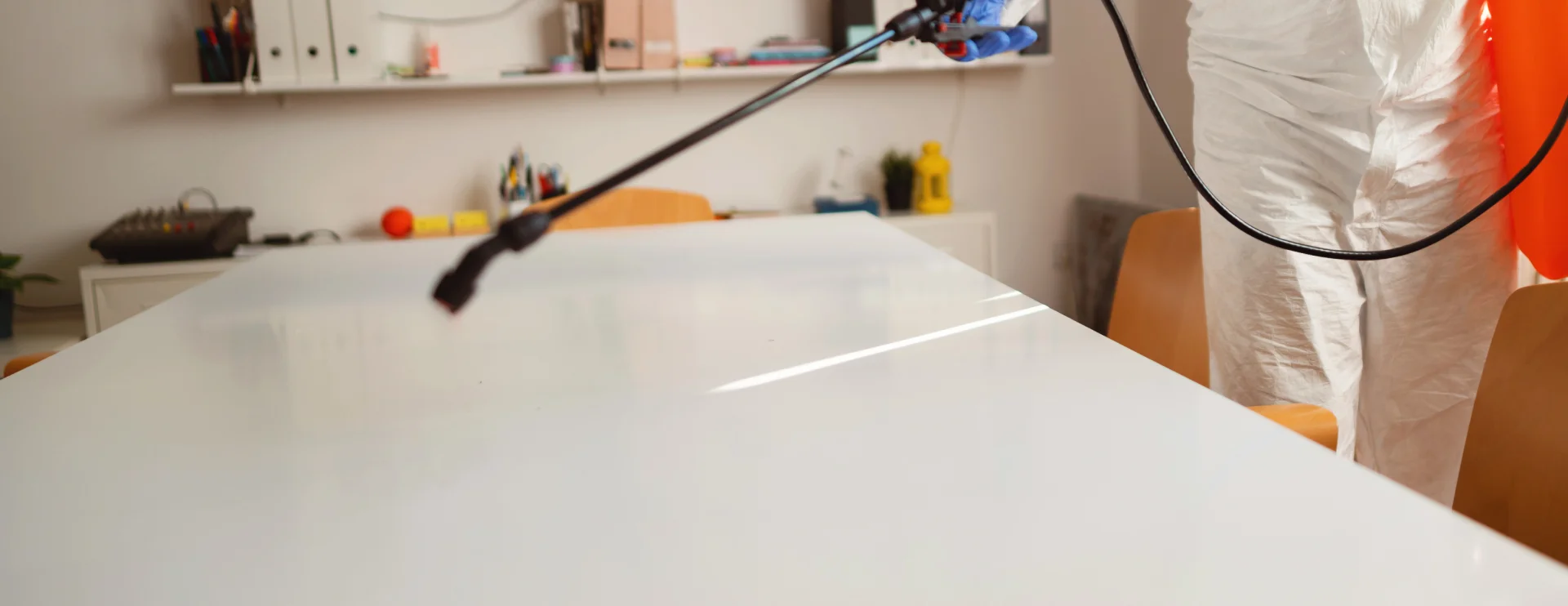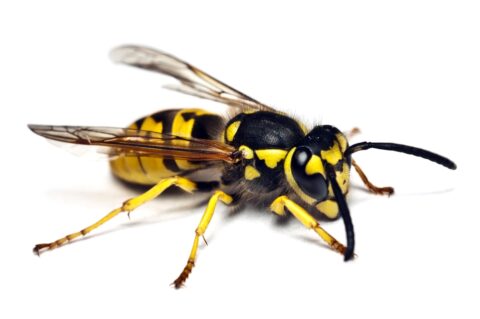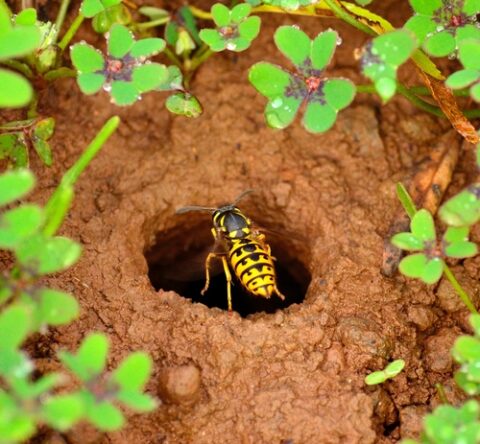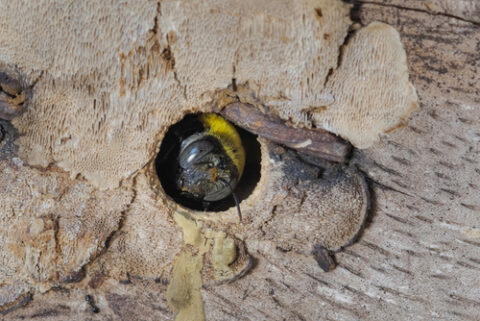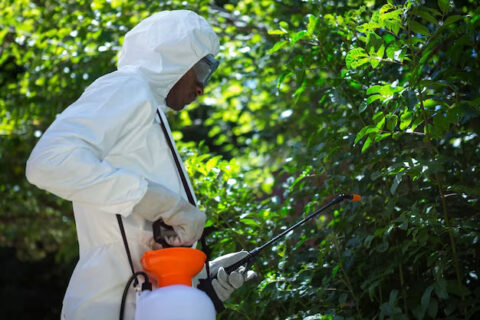As a homeowner, dealing with wasps and bees can be a daunting task, but understanding the different species and their behaviors is crucial for effective and safe control. Some of the most common wasp, and bee species found around homes include carpenter bees, Bald-faced hornets, European hornets, paper wasps, yellowjackets, mud daubers, European paper wasps, and cicada killer wasps. It should be noted that, wasps have distinct yellow/black bands around the abdomen whereas bees have a more non-descript light brown/brown-yellow color. Bees tend to be ‘hairy’ to allow pollen to be gathered more easily whilst wasps tend to be bald and shiny in appearance.
Wasps and hornets have similar hairless bodies. The major distinction lies in their size and coloration. Wasps are relatively smaller, ranging from around one-third of an inch to one inch in length. In contrast, hornets are larger insects. Wasps typically exhibit black and yellow rings or bands around their abdomens, while hornets sport black and white rings.
Both bees and wasps/hornets serve beneficial roles. Bees are crucial pollinators, aiding in plant reproduction and ecosystem maintenance. Meanwhile, wasps and hornets act as natural pest controllers, preying on other insects.
However, all three – bees, wasps, and hornets – can pose risks to humans. Their stings can be particularly dangerous for individuals allergic to their venom. It’s important to note that these insects will only sting when they perceive a threat to themselves or their nests. Bees do not survive after delivering a sting. In contrast, wasps and hornets can sting multiple times without perishing.
While beneficial in their respective roles, caution should be exercised when encountering any of these stinging insects, especially in proximity to their nests or when they exhibit defensive behaviors.
The Bees that we want to discuss for control are Carpenter bees because they can cause significant property damage by tunneling into wooden structures like decks, siding, and eaves. While the males are territorial and may fly aggressively, they cannot sting. However, females can deliver a painful sting if handled. Treating wood with insecticides or painting can help deter carpenter bees, and sealing existing tunnels can prevent further damage.
As for wasps and hornets, it can be noted that hornets are just large wasps and look like wasps. The next thing we will review on the wasps species is their nesting behavior (either solitary or social). The social wasps will be more aggressive because they can attack in swarms. Baldfaced hornets, European hornets, paper wasps, and yellowjackets are among the most problematic for homeowners. Their large, aerial nests can pose a significant sting risk, especially when located near doors, windows, or high-traffic areas. These wasps are highly defensive of their nests and will attack aggressively if disturbed.
Mud daubers and European paper wasps are generally less aggressive but can still deliver painful stings if their nests are threatened. Their mud or paper nests are often found in protected areas like eaves, overhangs, and attics.
Cicada killer wasps, despite their intimidating size and name, are generally not aggressive unless their ground nests are directly disturbed. However, their burrowing can create unsightly holes in lawns and gardens.
When dealing with wasp nests around the home, it’s essential to prioritize safety. Attempting to remove or treat nests yourself can be extremely risky, especially for those allergic to stings or when dealing with aggressive species like yellowjackets.
For small, easily accessible nests of less aggressive species like paper wasps or mud daubers, homeowners may consider using aerosol wasp sprays designed for direct nest treatment. These sprays contain insecticides that can kill the colony when applied correctly. However, it’s crucial to follow all safety precautions, including wearing protective clothing and spraying during the evening or early morning when wasps are less active.
For larger nests or those in hard-to-reach locations, it’s generally advisable to seek professional pest control services. Professionals have the necessary training, equipment, and experience to safely and effectively remove wasp nests without putting themselves or others at risk.
Proper prevention is also key to minimizing wasp problems around the home. Sealing cracks and crevices, removing potential nesting sites, and keeping areas clean and free of food sources can discourage wasps from establishing nests in the first place.
While some wasp species are considered beneficial predators of other insects, their presence near homes can still pose a significant risk, especially for those with allergies or small children. By understanding the different types of wasps, their behaviors, and the appropriate control methods, homeowners can take the necessary steps to manage these stinging pests safely and effectively.
| Pest | Appearance | Size | Nest | Nesting Behavior | Aggression Level | Benefits/Threats |
|---|---|---|---|---|---|---|
| Bumble Bee | Black and yellow fuzzy markings, overall fuzzy appearance | 1/2 – 1 inch | Made of pollen clumps, in ground or dense grass clumps, often reusing abandoned mouse nests | Soliltary, ground nesting bees where each female bee will create her own nest to lay her eggs | Generally non-aggressive, will sting if threatened or nest is disturbed | Beneficial pollinator, but can sting |
| Carpenter Bee | Resembles bumble bee but abdomen is shiny and mostly bare | 1/2 – 1 inch | Tunnels in decaying or dried wood, does not make nests/colonies | Solitary | Males are territorial and will fly aggressively but cannot sting. Females can sting but rarely do unless grabbed | Considered a property threat due to wood damage over time |
| Honey Bee | Orangish-brown or black | 1/2 – 5/8 inch | Hives made of wax with honeycomb structure, often in trees or buildings | Social, colonies of 20,000 – 80,000 | Only sting to defend hive if threatened | Important pollinator, produces honey, generally non-aggressive unless threatened |
| Baldfaced Hornet | Largely black with white face | 5/8 – 3/4 inch | Large aerial paper carton nests, exposed in trees, can reach 14 inches wide, 24 inches long | Social | Can be aggressive if nest is near structures they view as threatened | Predators of pest insects but nests pose sting risk near homes |
| European Hornet | Large, brown with yellow abdominal stripes, pale face | 3/4 – 1 1/4 inch | Paper carton enclosed in brown envelope, in barns, attics, trees, walls | Social | Generally non-aggressive unless nest is disturbed near structures | Beneficial predators but nests require control near homes |
| Mud Dauber Wasp | Slender, usually black, may have pale markings or metallic sheen | 1/2 – 1 inch | Mud tubes built side-by-side, on ceilings, eaves, walls, etc. | Solitary | Very rarely sting even if nest is approached | Beneficial predators of spiders, rarely a problem |
| Paper Wasp | Brown with yellow/reddish markings | 5/8 – 3/4 inch | Open paper nests shaped like upside-down umbrellas, often hanging from trees, buildings | Social | Can sting readily if nest is disturbed or threatened, otherwise non-aggressive | Beneficial predators but nests require control near homes |
| Yellowjacket | Yellow and black pattern | 3/8 – 5/8 inches | Paper carton nests underground or on structures like shrubs, buildings. Enclosed in layered envelope. | Social | Very readily sting if nest is approached or disturbed | Beneficial predators but extremely defensive of nests near homes |
| European Paper Wasp | Black with yellow bands on abdomen, yellow spots on face and body | 5/8 – 3/4 inch | Nests in trees, buildings, meadows. Warm terrestrial habitats. | Social, live in colonies with queen and worker hierarchies | Mobile and social but rarely aggressive unless threatened | Generally non-aggressive unless nest is disturbed |
| Cicada Killer Wasp / Sand Hornet | Large, black with yellow markings | 1 – 1.5 inches | Burrows in bare or sandy soil, often in lawns or gardens | Solitary | Males are territorial but do not sting. Females can sting but are generally not aggressive unless handled or nest is threatened. | Beneficial predators of cicadas. Can leave sandy holes/mounds in yard |

